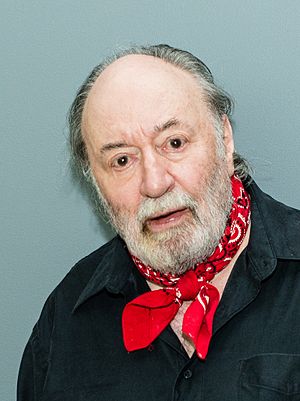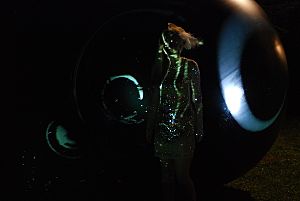Aldo Tambellini facts for kids
Aldo Tambellini (born April 29, 1930 – died November 12, 2020) was a famous Italian-American artist. He was a pioneer in a new art form called intermedia, which mixes different types of art. He was also a talented painter, sculptor, and poet. He passed away at the age of 90 in November 2020.
Contents
Early Life and Art Beginnings
Aldo Tambellini was born in Syracuse, New York. When he was very young, his family moved to Lucca, a town in Tuscany, Italy. He grew up speaking Italian. His grandfathers were interesting people: one owned a coffee farm in Brazil, and the other worked in a factory building train cars. Aldo spent most of his childhood with his mother's family.
From a young age, Aldo showed a great talent for art. He was drawing and painting skillfully by age three. When he was five, his mother gave him a battery-operated projector, which he loved. He also enjoyed music and singing. At age 10, he went to an art school where he studied art history and fine arts.
World War II's Impact
Soon after Aldo started art school, Italy joined World War II. This time had a big impact on his art. During a bombing raid on Lucca in 1944, Aldo was riding his bike. Bombs fell very close to him, but he survived. His family also survived, even though two bombs landed in their backyard without exploding. Sadly, many of his neighbors and friends died that day.
His family then moved to a nearby village called Guamo, which was occupied by German soldiers. Aldo remembered one young German soldier who liked his watercolors and also disliked the war. After the war, American soldiers called Buffalo Soldiers helped free Guamo. This event also influenced Aldo's artwork. He returned to Lucca to finish his art studies and even painted a mural for the American GI Club.
Moving to America and Education
Because Aldo was born in America, he was an American citizen. At 16, he moved to New York City with his mother. He spoke very little English at first. He discovered that his parents had officially separated. Aldo took care of his mother, who was struggling emotionally from the war.
He took many different jobs, like picking potatoes and painting large gasoline tanks. One time, he almost fell 60 feet from a tank, which could have been deadly. After this, he decided to enroll in a local college to learn English. There, he won many art awards.
Becoming an Art Teacher
At 17, Aldo showed his artwork to Lee Brown Coye, a famous illustrator. Coye was so impressed that he recommended Aldo to the director of the Syracuse Museum. Aldo was hired to teach painting, becoming the youngest teacher on staff!
At 18, he joined a group of artists called Group Center. He then earned a scholarship to Syracuse University for their art program. After getting his first degree, he taught at Rosary Hill College. He then received a special fellowship to study sculpture at Notre Dame with a famous sculptor named Ivan Meštrović. He earned his Master of Fine Arts degree in 1959.
Lower East Side Art Scene
After finishing his studies, Aldo moved to the Lower East Side in Manhattan, New York. This is where he truly became a professional artist. In the 1960s and 1970s, he started important art movements and was a key member of others.
Group Center and Black Film Series
In 1962, Aldo helped start Group Center. This group wanted to find new ways to show art that wasn't mainstream. They combined poetry, photography, dance, and filmmaking. It was here that Aldo began to use "black" as a main theme in his art.
He became a pioneering filmmaker. In 1965, he started painting directly onto film, a technique he invented. This became his "Black Film Series." He even won an international award for one of his experimental films, "Black TV," in 1969.
Electromedia Performances
Aldo also worked closely with the Umbra poetry collective, a group of Black poets. He became friends with many of them, like Ishmael Reed. Through these collaborations, Aldo pushed the boundaries of art even further. He created "electromedia" shows. These shows involved him painting on cellulose slides, which were then projected. They were accompanied by dancers, jazz music, and poetry.
His "electromedia" performances often included the poetry of Calvin C. Hernton. One famous work was Black Zero. These shows became very popular, with one newspaper calling it "Tambellini's Rebellion in Art Form." Black Zero has even been recreated many times in recent years at famous places like the Tate Modern in London.
The Gate Theaters
In 1966, Aldo founded The Gate Theater in New York. It showed experimental films once a week. Famous directors like Nam June Paik and Brian De Palma showed their first films there. In 1967, he co-founded another theater, the Black Gate, which focused on his electromedia performances.
Aldo was also part of the NO!art movement. This group's art often explored themes from World War II and the Holocaust, which were very important to Aldo.
Recent Exhibitions and Activities
Aldo Tambellini's work continued to be shown around the world.
In 2011, the Chelsea Art Museum in New York held a special show of his work called Black Zero (1966–1999). In 2012, he had an exhibition at the Tate Modern in London, where his installation Retracing Black became part of their permanent collection. He also had his first gallery show in New York in 2013.
In 2015, Aldo was invited to show his art at the famous Venice Biennale in Italy. He created a new multi-screen projection and a series of drawings. That same year, his video work The Circle in the Square was shown at the Boston Convention and Exhibition Center. This work featured actress Holly Payne-Strange.
In 2016, the Aldo Tambellini Art Foundation was created. This foundation helps to protect and promote Aldo's artwork. It also supports new artists who share his ideas. The foundation works to make sure Aldo's art is available for everyone to see in museums and galleries worldwide.
Artistic Style and Media
Aldo Tambellini created over 1400 pieces of art and 1000 poems. He worked with many materials, including bronze, coal, acrylic, and oil paints. His early works involved painting on slides and using projectors and televisions. His electromedia shows were team efforts, combining jazz, poetry, dance, and his painted slides. He was also a film editor and made visual poems.
His films often explored ideas about propaganda and how we see things. His major film "Black TV" used clips from television, which he edited together. His films were often black and white, dream-like, and had a social message. In 2006, his short film "Listen" won an award for Best Experimental film.
Aldo believed that communication itself was an art form. He was a pioneer in the video-art movement. His first videotape was shown on ABC TV News in New York in 1967.
From 1976 to 1984, Aldo was a Fellow at the Center for Advanced Visual Studies (CAVS) at the Massachusetts Institute of Technology. There, he taught about communication and media. He also did live experiments using "slow-scan" technology, which sends images slowly over long distances. In 1980, he started Communicationsphere, a group of artists and engineers interested in how telecommunications affect society.
Major Exhibitions
- 1968: "Black Gate Cologne" broadcast on German television.
- 1968: "Medium is the Medium," first broadcast by artists on WBGH, Boston.
- 1968: "Some More Beginnings" at the Brooklyn Museum, showing his video sculpture.
- 1969: "TV as a Creative Medium," the first video art gallery show in America.
- 1970: "Vision & Television Show" at Rose Art Museum, the first museum show of television as art in America.
- 1971: "Atlantic in Brooklyn," a solo show at "The Kitchen," NYC.
- 1971: Solo film show at the Museum of Modern Art, NYC.
- 1971: "A Special Video Show," first video art show at the Whitney Museum.
- 2011: "Black Zero" retrospective at the Chelsea Art Museum, NYC.
- 2012: "The Tate Tanks" at Tate Modern London, recreating "Black Zero" and "Moondial."
- 2015: Exhibited at the Italian Pavilion, Venice Biennale.
- 2017: Aldo Tambellini. Black Matters, ZKM Center for Art and Media Karlsruhe, Germany.
- 2018: Aldo Tambellini Room opens at The Tate Modern London.
Poetry
- 2017: A book of his selected poems, LISTEN - Selected poems of Aldo Tambellini 1946 to 2016, was published.
Personal Life
Aldo Tambellini lived in New York's Lower East Side and later Brooklyn. In 1986, he moved to Cambridge, Massachusetts. He met Anna Salamone, who became his partner and collaborator until his death.
See also
 In Spanish: Aldo Tambellini para niños
In Spanish: Aldo Tambellini para niños



